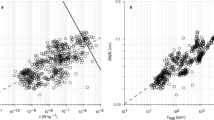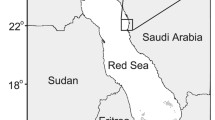Abstract
This work presents models of the vertical distribution and flux of phytoplankton aggregates, including changes with time in the distribution of aggregate sizes and sinking speeds. The distribution of sizes is described by two parameters, the mass and number of aggregates, which greatly reduces the computational cost of the models. Simple experiments demonstrate the effects of aggregation on the timing and depth distribution of primary production and export. A more detailed ecological model is applied to sites in the Arabian Sea; it demonstrates that aggregation can be important for deep sedimentation even when its effect on surface concentrations is small, and it presents the difference in timing between settlement of aggregates and fecal pellets.
Similar content being viewed by others
References
Alldredge A L and Gotschalk C 1988In situ settling behaviour of marine snow;Limnol. Oceanogr. 33(3) 339–351
Alldredge A L and Gotschalk C 1989 Direct observations of the mass flocculation of diatom blooms: characteristics, settling velocities and formation of diatom aggregates;Deep-Sea Res. 36(2) 159–171
Alldredge A L and McGillivary P 1991 The attachment probabilities of marine snow and their implications for particle coagulation in the ocean;Deep-Sea Res. 38(4) 431–443
Alldredge A L and Silver M W 1988 Characteristics, dynamics and significance of marine snow.Progress in Oceanography 20 (41–82)
Banse K 1987 Seasonality of phytoplankton chlorophyll in the central and northern Arabian Sea.Deep-Sea Res. 34 713–723
Banse K 1994 On the coupling of hydrography, phytoplankton, zooplankton, and settling organic particles offshore in the Arabian Sea;Proc. Indian Acad. Sci. (Earth Planet. Sci.) 103(2) 125–161
Bochdansky A B and Herndl G H 1992 Ecology of amorphous aggregations (marine snow) in the Northern Adriatic Sea. III. Zooplankton interactions with marine snow;Mar. Ecol. Progr. Ser. 87 135–146
Brock J C, McClain C R, Luther M E and Hay W W 1991 The phytoplankton bloom in the northwestern Arabian Sea during the southwest monsoon of 1979;J. Geophys. Res. 96(C11) 20623–20642
Brock T D 1981 Calculating solar radiation for ecological studies;Ecol. Model. 14 1–19
Brown P N, Byrne G D and Hindmarsh A C 1989 VODE: A Variable Coefficient ODE Solver;SIAM J. Sci. Stat. Comput. 10 1038–1051
Dam H G and Drapeau D T 1995 Coagulation efficiency, organic-matter glues and the dynamics of particles during a phytoplankton bloom in a mesocosm study;Deep-Sea Res. II 42(1) 111–123
Engel A 1998Bildung, Zusammensetzung und Sinkgeschwindigkeiten mariner Aggregate. Ber. Institut fur Meereskunde, Kiel 300. Christian-Albrechts-Universität zu Kiel, 145 pp.
Eppley R W, Rogers J N and McCarthy J J 1969 Halfsaturation constants for uptake of nitrate and ammonium by marine phytoplankton;Limnol. Oceanogr. 14 912–920
Evans G T 1999 The role of local models and data sets in the Joint Global Ocean Flux Study;Deep-Sea Res. I 46 1369–1389
Evans G T and Garçon V 1997One — dimensional models of water column biogeochemistry; JGOFS Report 23. Scientific Committee on Oceanic Research, Bergen, Norway, 85 pp.
Evans G T and Parslow J S 1985 A model of annual plankton cycles;Biol. Oceanogr. 3 327–347
Fasham M J R and Evans G T 1995 The use of optimization techniques to model marine ecosystem dynamics at the JGOFS Station at 47°N, 20°W;Phil. Trans. Roy. Soc. London B 348 203–209
Fasham M J R, Ducklow H W and McKelvie S M 1990 A nitrogen-based model of plankton dynamics for the oceanic mixed layer;J. Mar. Res. 48 591–639
Fowler S W and Knauer G A 1986 Role of large particles in the transport of elements and organic compounds through the oceanic water column;Prog. Oceanog. 16 147–194
Garrison D L, Gowing M M and Hughes M P 1998 Nano- and microplankton in the northern Arabian Sea during the Southwest Monsoon, August-September 1995: A US-JGOFS study;Deep-Sea Res. II 45(10–11) 2269–2299
Haake B, Ittekkot V, Rixen T, Ramaswamy V, Nair R R and Curry W B 1993 Seasonality and interannual variability of particle fluxes to the deep Arabian Sea;Deep-Sea Res. 40(7) 1323–1344
Haupt O J 1995Modellstudien zum pelagischen Stickstoffumsatz und vertikalen Partikelfluβ, in der Norwegensee; Berichte aus dem Sonderforschungsbereich 313 60. Christian-Albrechts-Universität zu Kiel, 140 pp.
Hurtt G C and Armstrong R A 1996 A pelagic ecosystem model calibrated with BATS data;Deep-Sea Res. II 43(2/3) 653–683
Jackson G A 1990 A model for the formation of marine algal flocs by physical coagulation processes;Deep-Sea Res. 37(8) 1197–1211
Keen T R, Kindle J C and Young D K 1997 The interaction of Southwest Monsoon upwelling, advection and primary production in the northwest Arabian Sea;J. Mar. Systems 13(1–4) 61–82
Krey J 1973 Primary Production of the Indian Ocean. Chap. 2.1, pages 155–126 In:The Biology of the Indian Ocean (ed) B Zeitzschel (Berlin: Springer)
Krey J and Babenerd B 1976Phytoplankton production. Atlas of the International Indian Ocean Expedition; Institut fur Meereskunde an der Christian-Albrechts-Universität Kiel, 70 pp.
Kriest I 1999The influence of phytoplankton aggregation on sedimentation — A model study; Ber. Institut fur Meereskunde 306. Christian-Albrechts-Universität zu Kiel, 136 pp.
Kriest I and Evans G T 1999 Representing phytoplankton aggregates in biogeochemical models;Deep-Sea Res. I 46 1841–1859
Lampitt R S 1985 Evidence for the seasonal deposition of detritus to the deep-sea floor and its subsequent resuspension;Deep-Sea Res. 32(8) 885–897
Lampitt R S, Hillier W R and Challenor P G 1993 Seasonal and diel variation in the open ocean concentration of marine snow aggregates;Nature 362 737–739
Latasa M and Bidigare R R 1998 A comparison of phytoplankton populations of the Arabian Sea during the spring intermonsoon and southwest monsoon of 1995 as described by HPLC-analyzed pigments;Deep-Sea Res. II 45(10–11) 2133–2170
Lee C, Murray D W, Barber R T, Buesseler K O, Dymond J, Hedges J I, Honjo S, Manganini S J, Marra J, Moser C, Peterson M L, Prell W L and Wakeham S G 1998 Particulate organic carbon fluxes: compilation of results from the 1995 US JGOFS Arabian Sea Process Study by the Arabian Sea Process Study;Deep-Sea Res. II 45(10–11) 2489–2501
McCreary J P, Kohler K E, Hood R R and Olson D B 1996 A four-component ecosystem model of biological activity in the Arabian Sea;Prog. Oceanog. 37 193–240
Morrison J, Codispoti L A, Gaurin S, Jones B, Manghnani V and Zheng Z 1998 Seasonal variation of hydrographic and nutrient fields during the US JGOFS Arabian Sea Process Study;Deep-Sea Res. II 45(10–11) 2053–2101
Nair R R, Ittekkot V, Manganini S J, Ramaswamy V, Haake B, Degens E T, Desai B N and Honjo S 1989 Increased particle flux to the deep ocean related to monsoonsNature 338 749–751
Noji T 1989The influence of zooplankton on sedimentation in the Norwegian Sea; Ber. Sonderforschungsbereich 313 17. Christian-Albrechts-Universität zu Kiel, 183 pp.
Oschlies A, Koeve W and Garçon V 2000 An eddy-permitting coupled physical-biological model for the North Atlantic. 2. Ecosystem dynamics and comparison with satellite and JGOFS local studies data;Global Biogeochemical Cycles. 14 (1) 499–523
Pollehne F, Klein B and Zeitzschel B 1993 Low light production and export production in the deep chlorophyll maximum layer in the northern Indian Ocean;Deep-Sea Res. II 40(3) 737–752
Reed R K 1976 On estimating insolation over the ocean;Journal of Physical Oceanography 7 482–485
Riebesell U 1991 Particle aggregation during a diatom bloom. I. Physical aspects;Mar. Ecol. Progr. Ser. 69 273–280
Riebesell U and Wolf-Gladrow D 1992 The relationship between physical aggregation of phytoplankton and particle flux: a numerial model;Deep-Sea Res. 39(7/8) 1085–1102
Ruiz J and Izquierdo A 1997 A simple model for the break-up of marine aggregates by turbulent shear;Oceanologica Acta 20(4) 597–605
Schnack S 1983 On the feeding of copepods onThalassiosira parthenia from the Northwest African upwelling area;Mar. Ecol. Progr. Ser. 11 49–53
Smayda T J 1970 The suspension and sinking of phytoplankton in the sea;Mar. Biol. Ann. Rev. 8 353–414
Smayda T J and Boleyn B J 1965 Experimental observations on the flotation of marine diatoms. II.Skeletonema costatum andRhizosolenia setigera;Limnol. Oceanogr. 11 18–34
Smith S L 1982 The northwestern Indian Ocean during the monsoons of 1979: distribution, abundance, and feeding of zooplankton;Deep-Sea Res. 29(11A) 1331–1353
Smith Jr K L, Baldwin R J, Glatts R C, Kaufmann R S and Fisher E C 1998 Detrital aggregates on the sea floor: Chemical composition and aerobic decomposition rates at a time-series station in the abyssal NE Pacific;Deep-Sea Res. II 45 843–880
Waite A, Bienfang P K and Harrison P J 1992 Spring bloom sedimentation in a subarctic ecosystem. I. Nutrient sensitivity.Mar. Biol. 114
Waite A M and Thompson P A 1992 Does energy control the sinking rates of marine diatoms?Limnol. Oceanogr. 37(3) 468–477
Young D K and Kindle J C 1994 Physical processes affecting the availability of dissolved silicate for diatom production in the Arabian Sea;J. Geophys. Res. 99(C11) 22619–22632
Author information
Authors and Affiliations
Rights and permissions
About this article
Cite this article
Kriest, I., Evans, G.T. A vertically resolved model for phytoplankton aggregation. J Earth Syst Sci 109, 453–469 (2000). https://doi.org/10.1007/BF02708333
Issue Date:
DOI: https://doi.org/10.1007/BF02708333




